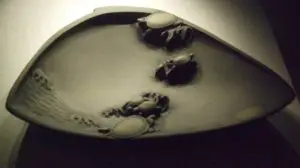Shufa 书法, or Chinese calligraphy, may seem a bit daunting at first, a practice better left to a professional, an artist, or better yet some Chinese scholar?? Yet the benefits of Chinese calligraphy have been discussed for thousands of years.

What it takes to perfect the art of calligraphy is personified by the family of Wang Xizhi王羲之, who was one of the most famous calligraphers in history. His son Wang xianzhi王献之 also practiced calligraphy ardently, trying to follow in his father’s footsteps.
Legend has it that one day the son was practicing calligraphy, and found pride in the character “大” dà (meaning big) he had written. He excitedly brought the character to his father, hoping to impress. Without further comment, his father added a dot at the bottom, which turned the character into the word “太” tài(meaning too).
The son then took the scroll to his mother. She exclaimed: Son, all your efforts and hard work have culminated in writing this “dian” at the bottom, congratulations! The son hung his head and explained that this was the father’s addition, adding, “What will it take to become as good as Father?” Mother said, “If you finish using all 7 tubs of water outside the house for calligraphy practice, then you will obtain your desired level.” Since ink is created from adding a small amount of water to an inkstone and then rubbing down an inkstick, this would be a considerable amount of practice. Ultimately the son became a master of calligraphy in his own right, as did many generations of the Wang family.
The Wang family’s mastery of calligraphy has been celebrated for centuries. The main takeaway of this story is that even his skill is obtainable with the right amount of dedication. For those aiming just a bit lower, calligraphy still offers a structure for learning that is incredibly approachable. A popular way to practice calligraphy is to use model templates, almost akin to coloring. Even experienced calligraphers often learn by imitating the work of the masters.

新加坡康熙文物展 Inkstone from Qing Dynasty Emporer Kangxi
Muscle memory from repeated practice and a trained eye eventually results in symmetrical, aesthetically pleasing characters. After learning the foundation of calligraphy, many artists imbue their own sense of style to the art. An innate talent is not necessarily required.
The practice extends outside of China to many countries in Asia. In fact Japan, which uses Chinese characters in Japanese (called kanji), practices Japanese calligraphy with heavy Chinese influence. S. Korea similarly evolved its calligraphy from the Chinese art, and many Korean scholars learned Chinese characters to practice the art, since Korean is based on an entirely different alphabet.
Shufa as an art form or writing form has several notable benefits:
Language familiarity/learning
With the advent of computers and cell phones, character amnesia has become an issue even in countries where Chinese is the native language. Not only are characters complicated, but handwriting has been replaced by typing. Studies show that handwritten notes link knowledge to the brain better than with typing. In Chinese characters are broken down into components or even English letters (pinyin) for fast typing, basically eradicating any connection typing has to the language.
Chinese characters have a natural connection to imagery,having been direct derivations of pictographs, which heavily influenced the evolution of calligraphy fonts:
Trying to take advantage of this pictoral link was likely the motivation behind kickstarter project Chineasy, which transforms the most commonly used characters into picture flashcards that aid the learner.
Shufa provides another effective tool for learning, this time by offering a tangible artistic project. While refining artwork, practicing Chinese calligraphy becomes a way to reinforce those difficult Chinese characters.
Hand eye coordination
The most standard calligraphy styles require precise brush strokes. The symmetry of each character and the characters in relation to each other contribute to the aesthetic quality of the finished work. The thickness of each line is generally proportionate and in keeping with the character’s structure. Every time there is a turn or connected stroke, the brush requires a fine mastery of the brush.
The strictest calligraphy masters spend thousands of hours practicing a single stroke or dot of the brush, akin to studying how to paint a comma for hours.
The good news is that all of this can be learned and perfected by practice. The mind’s plasticity enables all of us to obtain new skills at an incredible level through continuous refinement. Also with a few templates, beginners can grasp the brush work with guidance.
Breath work
Shufa has been thought to have therapeutic and life extending qualities for thousands of years. The art can be a deeply meditative practice stemming from the breath and control necessary to position the brush.
In general, the heart has to be still and calm in order to produce fine art. Achieving stillness through breath is a common thread of meditative practices, and shufa is another art where this therapy comes into play.
Entering a state of flow
Psychologists have referred to flow as the state where the mind enters its highest performing level. The rhythmic nature of brush writing lends itself to a full state of immersion. While becoming lost in the art of calligraphy, time becomes just another dimension.
Shutting off the screen
A massive proportion of our lives involves some type of screen these days. In yoga class my teacher enjoyed reminding us that we spend much of our lives staring at a piece of glass. Just because that screen is interactive, it has become the instrument of choice in our free time. It’s certainly replaced the pen and paper to a large extent.
I’m personally a bit skeptical that in our natural state we were meant to spend so much time staring at a fixed man-made target. And actually having an excuse to paint or write is a a relief
In today’s fast paced manic world, Shufa has the potential to pin artists down into a contemplative, relaxed state.

